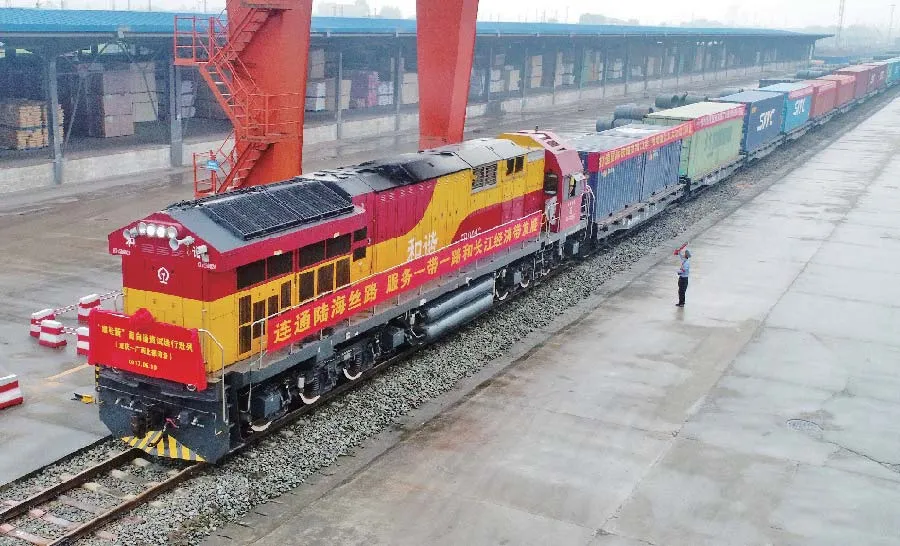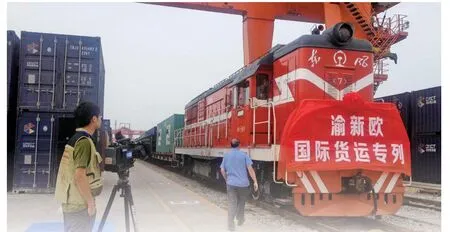渝桂新“南向通道”:钢铁驼队的出海之路
□ 文/本刊记者 黎敏
渝桂新“南向通道”:钢铁驼队的出海之路
□ 文/本刊记者 黎敏
黄沙大漠,商旅不绝,2000多年前的丝绸之路上,骆驼承包了大部分的载货业务。而今,声声驼铃换成了火车呼啸的风声,一列列钢铁驼队寻迹丝路古道,跑出了新的精彩:依托中欧班列,“一带一路”上架起了3条连接亚欧大陆的桥梁,3000列钢铁驼队,往返穿梭于大桥两端,近60个城市,连通着世界的东西南北。
其中,中国重庆是首条中欧班列“渝新欧”的诞生之地,时隔6年,“渝新欧”已成为中国首个突破千列的中欧班列。眼下,山城重庆正依托“渝新欧”一线,借势中新(重庆)战略性互联互通示范项目的落户,积极尝试开辟南向通道,与新加坡加强连通。作为“渝新欧”极富创意的延伸,这条南向通道被称为“渝桂新”。
从“渝新欧”到“渝桂新”,从大陆到海洋,随着两段线路的连接,驰骋于陆路的钢铁驼队,将走向更宽广的大海。
为了共同的目标
属于中欧班列西线的“渝新欧”,从中国重庆出发,经新疆阿拉山口出境,终点在德国的杜伊斯堡。沿途通关监管互认、信息共享,运输全程只需一次申报、一次查验、一次放行。自2011年开通以来,“渝新欧”班列数量占全中国中欧班列数量的45%左右,实力可见一斑。
随着2013年“一带一路”倡议的提出,加强互联互通被放到了极为重要的位置。重庆作为“一带一路”和“长江经济带”的联结点,对于建设成为中国内陆国际物流枢纽和口岸高地,增强“渝新欧”对东盟的辐射力和影响力,开始有了更高的要求。2015年,中国和新加坡第三个政府间合作项目——中新(重庆)战略性互联互通示范项目正式落户重庆,更增添了重庆建设南向通道的底气。
在打造“铁空联运”4小时辐射圈后,重庆将目光投向了比空运更稳定、实惠的铁路运输。毗邻东盟的广西北部湾经济区,作为中国西南内陆地区最近的出海通道,成为重庆连通新加坡再出海的一个上佳选择。而这也正好契合国家赋予广西的“三大定位”以及广西北部湾经济区新一轮开放开发的升级需要。
中国国家主席习近平2017年4月在广西考察时指出,广西要建设好北部湾港口,打造好向海经济。而发展向海经济的要义不仅包括走向海洋,也包括海陆联动,对接内陆腹地,争取资源的优化配置。
目前钦州港作为北部湾港集装箱业务的核心,货运多数来自云南昆明,货物主要为出口到印尼等东盟国家的化肥。如果跟占据长江80%运力的重庆实现海铁联运,那么长江沿线的笔记本电脑、摩托车、化工品等货源就有望流入。这不仅将降低企业运输的成本,增加钦州港的集装箱吞吐量,更将成为广西践行“三大定位”的务实之举。
而新加坡作为国际航运中心,更高效、多元、开放的交通联运,显然也有利于新加坡本国经济的发展。正因为开辟南向通道符合中国重庆、广西与新加坡的共同需要,所以渝桂新“南向通道”的建设才从推进之初就得到三方的共同认可,并不断取得新的突破。
不止是海铁联运
2017年5月10日,载着重庆当地生产的高档生活用纸、摩托车等产品,首趟渝桂新(重庆—钦州)“南向通道”试运行班列开行。经过近48小时的行程,该班列顺利抵达广西北部湾钦州港东站。在港口完成了货物通关手续后,货物下水出海,前往新加坡。就在一个月前的4月28日,首趟渝桂新(钦州—重庆)试运行班列也成功开行,至此,渝桂新“南向通道”试运行班列已成功完成上下对开。
相较于原有铁路零散运输,渝桂新“南向通道”的班列可节约2天以上的时间;较重庆至上海经长江的河运,能节约12天以上的时间。在钦州保税港区海关国检的配合下,运抵钦州保税港区的重庆外贸货物仅需4天时间就能完成货物出口。一条高效、便捷的运输通道已经轮廓清晰。接下来,三方还将成立合资公司,搭建南向通道公共平台,加快一体化物流信息系统建设,以尽早实现渝桂新“南向通道”班列正式开行。
根据广西壮族自治区副主席张晓钦的介绍,中国广西、重庆与新加坡对渝桂新“南向通道”的建设已取得共识,并于2017年4月28日签署了合作框架协议。三方合作的具体内容包括:开通铁路集装箱班列,形成由重庆,经广西北部湾港,到新加坡的海陆联运线路;开通中国至中南半岛的公路货运直通车,形成由重庆经广西到新加坡的陆路通路;扩展空中航空物流的合作,将在南宁合作建设中新大型综合物流园区;合作推动通关便利化,拓展信息物联,探讨跨境电商、智慧物流的合作等。
可以说这是一条海陆空齐头并进的通道,也是一条从基建到信息都互联互通的坦途。为了寻求公路、物流领域合作的突破,2017年5月18日,位于广西北部湾经济区内的凭祥综合保税区与重庆公路运输(集团)有限公司签订战略合作框架协议,将共同打造渝桂新“南向通道”(重庆—凭祥—东盟)便捷物流线路。
对此,中新(重庆)战略性互联互通示范项目管理局局长韩宝昌表示,在“一带一路”大背景下,大通道是一个多层次的大概念,包括铁路、公路等方面;也是多线路、多运输的概念,南向通道的内涵应该是极其丰富的。

渝桂新“南向通道”试运行班列
钢铁驼队遇见现代宝船
当钢铁驼队依托中欧班列成为丝绸之路经济带上一道亮丽的风景时,北部湾畔,已与7个东盟国家的47个港口建立海上运输往来的广西北部湾港,正以集装箱外贸班轮作为现代宝船,在21世纪海上丝绸之路上破浪前行。
而随着渝桂新“南向通道”建设的推进,陆与海的联动将释放巨大的发展机遇。经广西出海的这条大通道,将重塑沿长江运输至上海绕行大半个中国海岸线到东盟的传统路线;同时通过“渝桂新”衔接“渝新欧”,经由重庆连接东南亚至欧洲,构成辐射范围更广的亚欧陆上新通道,实现“一带一路”与“长江经济带”的有效连接,带动中国西部地区开发开放、协同发展。
重庆作为中国西部的重要城市及该线路的核心枢纽,重庆工商大学经济学院院长李敬认为,渝桂新“南向通道”的开通,标志着重庆能够“下南洋”,开辟出一条“走出去”的新方向,也将实现重庆由长江上游航运中心向内陆国际物流枢纽转变。
广西壮族自治区党委书记彭清华则表示,中国西南地区最便捷的出海通道在北部湾,渝桂新“南向通道”由重庆经广西沿海、沿边连通新加坡,向北连接丝绸之路经济带,向南连接21世纪海上丝绸之路和中南半岛,将形成“一带一路”经西部地区的完整环线和陆海贸易新通道,对广西融入“一带一路”建设、深化与新加坡交流合作意义重大。而富集广西海陆通道资源的北部湾经济区也将因此获得新一轮开放开发,以及打造向海经济的强大动能。
除了加快中国西部地区的开发开放,“把‘南向通道’打造成为中国‘一带一路’的示范项目,不单是看重庆和西南省份借道北部湾港出口到海外的货量,反过来的北向贸易同样值得期待。”新加坡太平船务集团董事总经理张松声举例,马来西亚的咖啡从新加坡出海到钦州港,可一路北上分拨到云南、重庆、四川,再通过重庆的“渝新欧”班列,经新疆阿拉山口出境到哈萨克斯坦等中亚地区,“这将改变东南亚货物目前经由伊朗中转的旧有方式。”
从内陆走向海洋,是经济全球化的驱使,从海洋走向内陆,是开拓市场的探寻与向海经济的延伸。渝桂新“南向通道”衔接的将不仅是沿线各个城市的发展诉求,更有丝路钢铁驼队南下出海与海丝现代宝船北上掘金的合作机遇。当“一带一路”形成一个有机衔接的整体,它将给这个世界带来更多的惊喜。
·联系编辑:313464302@qq.com

On the ancient Silk Road over 2,000 years ago, camels were seen as a means of transporting a majority of goods, while their role now has been replaced by fully-loaded trains.To date, there are three bridges linking Asia and Europe that have been set up for 3,000 regular trains, which pass through nearly 60 cities.
Six years ago, Chongqing-Xinjiang-Europe Railway Line (CXERL), the first of its kind connecting China with European countries, was opened in Chongqing, China. Now, it ranks first in terms of the number of regular trains — more than 1,000 — travelling along the route. With China-Singapore(Chongqing) Demonstration Initiative on Strategic Connectivity (CSCDISC)launched, Chongqing is energetically attempting to build a southward passageway — namely, Chongqing-Guangxi-Singapore Southward Passageway (CGSSP) — an extended part of CXERL, which leads to Singapore from Chongqing.
Sharing a common goal
Starting from Chongqing, China, the westward CXERL passes through Xinjiang’s Alataw Pass, a border site in northwest China, and eventually reaches Duisburg, Germany. Throughout the journey, mutual recognition has been realized in terms of customs clearance and supervision, and so has information sharing; meanwhile, once-for-all service applies to declaration, inspection and customs clearance. Since 2011, the number of regular trains travelling along the route accounted for nearly 45% of the total.
With the Belt and Road Initiative proposed in 2013, it is imperative to enhance connectivity between China and countries along the route.In such a circumstance, Chongqing,as a junction between the Belt and Road Initiative and the Yangtze River Economic Zone, focuses more on building itself into an international logistics hub and an important inland port in China and on strengthening its presence in ASEAN countries. In 2015,for instance, CSCDISC — the third inter-governmental project initiated by Singapore and China — was officially implemented in Chongqing, contributing to the construction of the southward passageway.
After completing a “Four-hour Circle of Transportation” fusing railway and air routes, Chongqing has shifted its focus to railway transportation, which is considered more stable and affordable than air transportation. Guangxi Beibu Gulf Economic Zone (GBGEZ) —adjacent to ASEAN — is the nearest access to the sea in southwest China,so it is regarded as an excellent place for Chongqing to connect itself with Singapore. Virtually, not only does building the passageway dovetail with Guangxi’s three development orientations — to be an international access towards ASEAN, a new strategic fulcrum to bolster the opening-up and development of southwestern and southcentral China and a crucial gateway to make the Belt and Road organically linked — granted by the state, but also it is an integral requirement for upgrading the opening-up and development of GBGEZ.
Furthermore, Chinese President Xi Jinping stressed that Guangxi should be committed to constructing ports in Beibu Gulf and to developing maritime economy on a facts-finding visit to Guangxi in April 2017. To reach this goal, we should strive to optimize the allocation of resources by highlighting marine industry, integrating sea-based and air-based routes and engaging with regions in the hinterland of China.
As for Singapore, an international shipping center, building a more ef fi cient, diversi fi ed and open integrated transport system would evidently boost its economic development. It is a common goal for Chongqing, Guangxi and Singapore to build the passageway,thus making new breakthroughs in advancing the project.
A passageway with multiple
dimensions
On May 10, 2017, the fi rst regular train travelling along CGSSP, loaded with cargoes like high-grade household paper and motorcycle produced in Chongqing,was put into its trial operation. It took nearly 48 hours to travel from Chongqing to Qinzhou Port East Railway Station in Guangxi. With the customs clearance procedure completed,the train continued to steer for its destination — Singapore. As a matter of fact, the first train from Qinzhou to Chongqing had been put into trial run on April 28, 2017. Under the coordination of China Entry-Exit Inspection and Quarantine Bureau in Guangxi Qinzhou Free Trade Port Area, it takes only four days to complete the export formalities of cargoes from Chongqing. Chongqing,Guangxi and Singapore, according to the plan, will set up a joint venture to accelerate the building of an integrated logistics information system, so as to ensure that trains travelling along the passageway can run of fi cially soon.
Zhang Xiaoqin, deputy governor of Guangxi Zhuang Autonomous Region,indicated that Guangxi, Chongqing and Singapore have reached a consensus on CGSSP, collectively signing a cooperation framework agreement on April 28, 2017, the contents of which are involved in the regular trains loaded with containers from Chongqing to Guangxi’s Beibu Gulf Port and eventually to Singapore, the highway freight transportation route linking China and the Indo-China Peninsula, the cooperation in air logistics, and so on.Moreover, on May 18, 2017, Pingxiang Integrated Free Trade Zone, located in GBGEZ, signed a framework agreement with Chongqing Highway Transportation Group, which is aimed at building a southward logistics route linking Chongqing, Pingxiang and ASEAN.
Han Changbao, director of China-Singapore (Chongqing) Demonstration Initiative on Strategic Connectivity Authority, stated that, under the Belt and Road Initiative, the passageway should be a concept of multiple dimensions,which not only includes railway,highway and so on, but also involves various routes and a diversi fi ed portfolio of transportation means.
A transportation system of trains and container liners
Guangxi Beibu Gulf Port has established marine transportation ties with 47 ports in seven ASEAN countries, and its regular foreign trade liners loaded with containers are sailing along the 21stCentury Maritime Silk Road.
As the construction of CGSSP advances,the traditional transportation route from Chongqing to ASEAN will be changed.The CXERL connects to the Silk Road Economic Belt in the north while the CGSSP leads to the 21stCentury Maritime Silk Road as well as the Indo-China Peninsula in the south, making the Belt and Road linked with the Yangtze River Economic Zone and powering the development and opening-up of and the synergy of China’s western regions.
Chongqing is a significant city in western China and a transportation hub of the route. Li Jing, dean of the School of Economics, Chongqing Technology and Business University,believed that opening CGSSP indicates that Chongqing will blaze a new trail of“going global”, and will change its role as a shipping center on the upper reaches of the Yangtze River into an inland international logistics hub.
Peng Qinghua, Secretary of the Party Committee of Guangxi Zhuang Autonomous Region, noted that the most convenient access to the sea is located in Beibu Gulf, and that it will be signi fi cant for Guangxi’s inclusion into the Belt and Road construction and for the exchanges and cooperation with Singapore to make CGSSP linked with its northern and southern destinations; besides,boasting resources required by land and sea routes, GBGEZ will embrace a new round of opening-up and development,and it will be considerably boosted to develop maritime economy.
When stepping up the opening-up and development of China’s western regions and making CGSSP a demonstration project of the Belt and Road Initiative,the existing route of transporting Southeastern cargoes will be gradually changed. Malaysia’s coffee, for example,can be shipped from Singapore to Qinzhou Port, allocated northwards to China’s Yunnan, Chongqing and Sichuan, and then delivered via the Alataw Pass to Central Asian countries like Kazakhstan along the CXERL,according to Teo Siong Seng, managing director of PIL-Pacific International Lines.
Chongqing-Guangxi-Singapore “Southward Passageway”:An Access for Trains Heading Towards the Outside World
Written by Li Min / Translated by Xu Zhiliang

